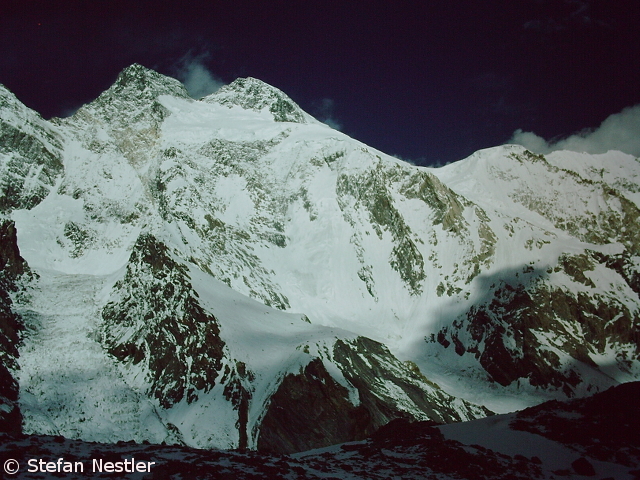
“Two days ago, above base camp, Ismail Akbarov from Azerbaijan was hit by a stone. This was his first ascent, and it also marked the end of his expedition. The impact damaged his tibia so that he had to be flown by helicopter to Skardu,” wrote Lukasz Supergan from Poland, who is attempting the 8,051-meter-high Broad Peak in the Karakoram in Pakistan this summer, on Instagram yesterday. He himself decided to start in the middle of the night rather than in the morning so as not to kick rocks loose and endanger those climbing below him.
Not only from Broad Peak, but also frp, neighboring K2 and the other eight-thousanders in Pakistan, Gasherbrum I, Gasherbrum II and Nanga Parbat, exceptionally dry conditions on the mountain are currently reported, accompanied by an increased risk of falling rocks. The usual precipitation has largely failed to materialize so far. Nevertheless, light snowfall is expected in the Karakoram in the coming days.
Blazing furnace Chilas
Overall, however, the consequences of climate change cannot be overlooked in the mountains of Pakistan either. Last Saturday, a heat record of 48.5 degrees Celsius was measured in the town of Chilas near Nanga Parbat. In Skardu, the starting point for most expeditions to the Karakoram, the thermometer also rose to around 40 degrees Celsius. As a result of the high temperatures, ice and snow are melting even faster than before.

“I think that in future, expeditions will have to go to Pakistan earlier – because of the climate change that is very clearly noticeable there,” David Göttler told me after his return from Nanga Parbat. “That would clash with the spring season in Nepal. The expeditions would have to travel on to Pakistan immediately after the end of their projects in Nepal. But I think that’s unavoidable.”
Objective dangers are increasing
Göttler and his French team partners Tiphaine Duperier and Boris Langenstein had pre-acclimatized in Nepal for their later successful ascent of Nanga Parbat: on the 6,145-meter-high Island Peak and the 7129-meter-high Baruntse.

“It’s crazy how quickly these mountains are changing,” says Göttler. “The objective dangers are getting bigger, rockfall is increasing. On Baruntse, for example, the summit ridge is now really dangerous. There are huge crevasses that you have to find your way around. It didn’t used to be a very challenging mountain. But now, even as a beginner on a seven-thousander like this, you have to be good with crampons.”
According to David, the six- and seventhousanders in particular will become much more difficult as a result of climate change, “and then perhaps a little less challenging again later – when all the glaciers have disappeared.”
ICIMOD warns of GLOFS
The International Centre for Integrated Mountain Development (ICIMOD) in Nepal today warned of the recent rapid increase in the number of flood events due to the collapse of natural dams in glacial lakes. On Monday alone, there were two such GLOFS (Glacial Lake Outburst Floods) in Nepal, one in Upper Mustang in the north of the country and one in the Rasuwa district on the border with Tibet.
At least 19 people are still missing after the flood disaster in Rasuwa – triggered by heavy rainfall, apparently exacerbated by a glacial lake outburst flood. Eight bodies have been recovered. Among other things, the masses of water had washed away a border bridge to Tibet.








